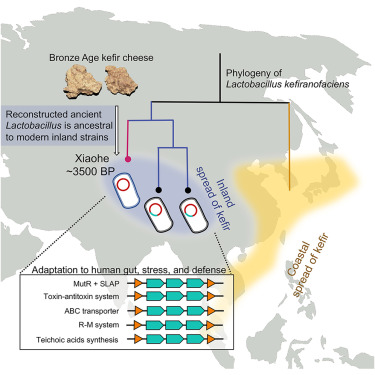Research Highlight from Asia - Ancient Cheese Holds Clues to Human-Microbe Evolutionary Dance
In a groundbreaking study published in Cell, an international team of scientists has peered into the past to reveal the intricate relationship between humans and microorganisms through the analysis of ancient cheese. This discovery not only sheds light on the origins of kefir in East Asia but also provides insights into how human activities have shaped the evolution of microbes we interact with daily.
The consumption of fermented dairy products like kefir has a long history, yet the microbial transformations and human innovations that occuhhed over time have been elusive. With limited archaeological records and the poor preservation of dairy remains, the detailed history of fermented dairy production techniques and the evolution of fermenting microbes has been challenging to trace. However, ancient DNA (aDNA) retrieved from Bronze Age cheese residues has opened a new window into this past.

Fig. Graphical abstract from reference
The researchers extracted aDNA from three Bronze Age cheese samples found in the Xiaohe cemetery in Xinjiang, China. The samples, estimated to be around 3,500 years old, were identified as kefir cheese—a traditional fermented dairy product. Using a combination of metagenomic analysis, DNA capture techniques, and whole-genome sequencing, the team explored the microbial content of the ancient cheese and reconstructed the genomes of Lactobacillus kefiranolyticus strains, a key bacterium in kefir fermentation.
The study revealed that the ancient cheese contained DNA from both bovine and caprine milk, suggesting that the Bronze Age people of Xinjiang used different batches of milk, rather than mixing them. The researchers also found that the L. kefiranolyticus strains from the ancient cheese samples were distinct from modern strains, indicating a separate spreading route of kefir from Xinjiang to inland East Asia.
The analysis of the L. kefiranolyticus genomes showed evidence of ongoing adaptation through horizontal gene transfer (HGT). The ancient strains had acquired multiple gene clusters that provide resistance to environmental stress, possibly as a result of adaptation to various ecological niches and human selection. The team also identified regions in modern strains that were likely acquired through HGT, which could be linked to the reduction of gut inflammatory responses, a feature that might have been selected by humans over the long-term kefir-making process.
This research highlights the significant role of human activities in the evolution of microbes that we interact with. The findings provide a deeper understanding of how our ancestors' lifestyle and cultural practices influenced the development and spread of fermented dairy products. The discovery of distinct spreading routes of kefir and the identification of ancient microbial strains offer a new perspective on the history of human-microbial interactions.
——
REFERENCES
Liu et al., Bronze Age cheese reveals human-Lactobacillus interactions over evolutionary history, Cell (2024), https://doi.org/10.1016/j.cell.2024.08.008